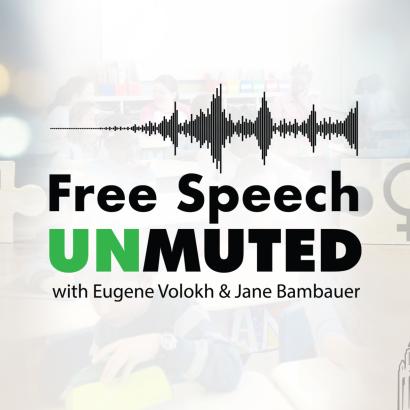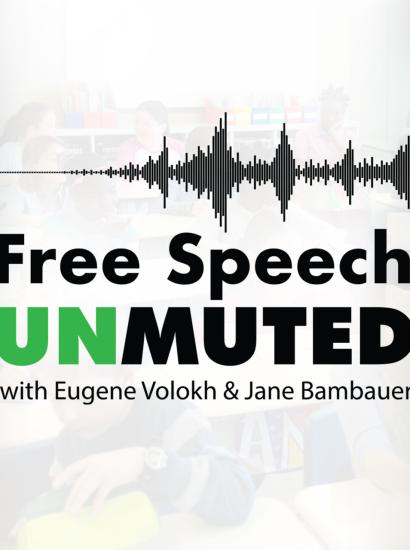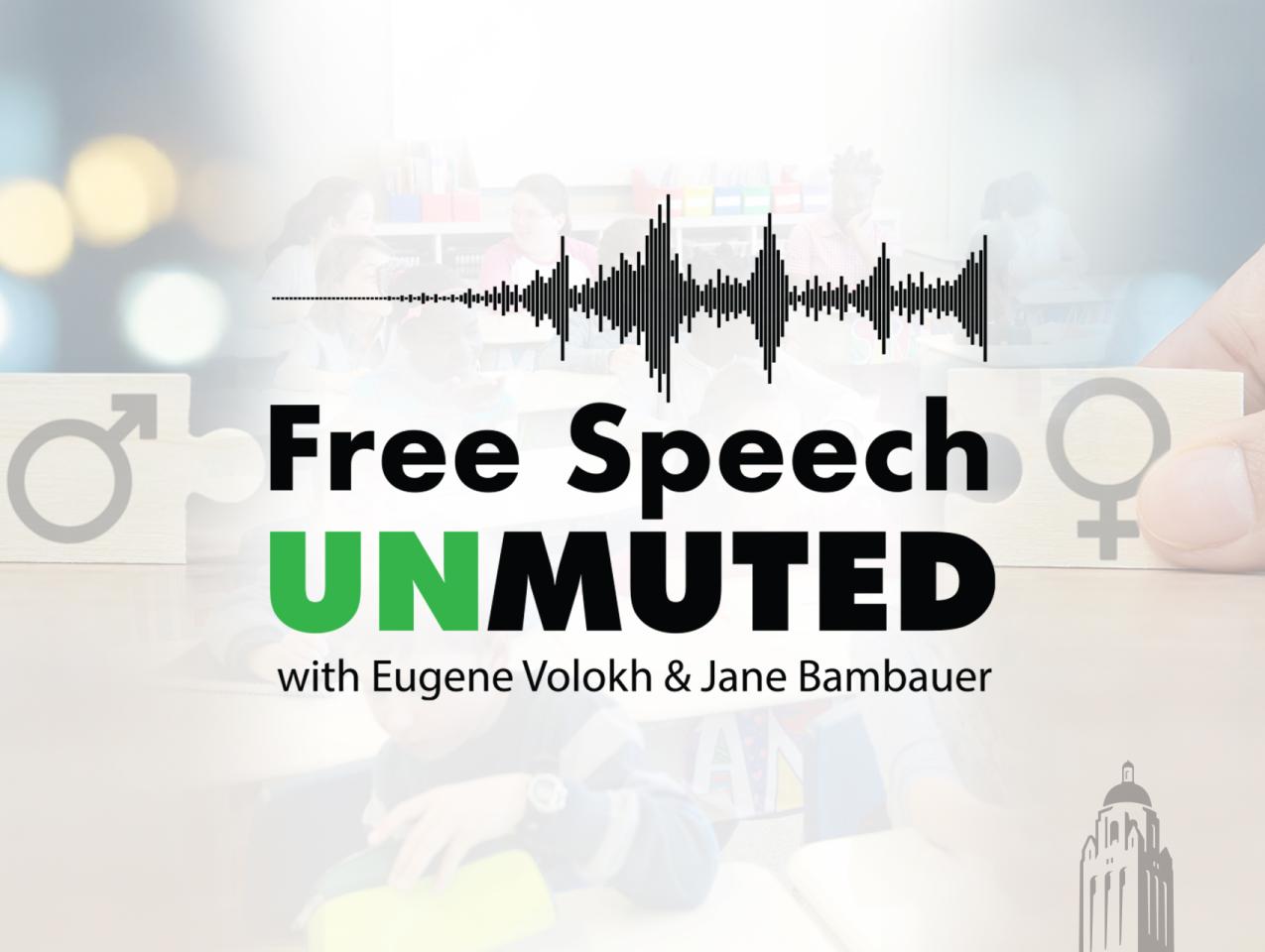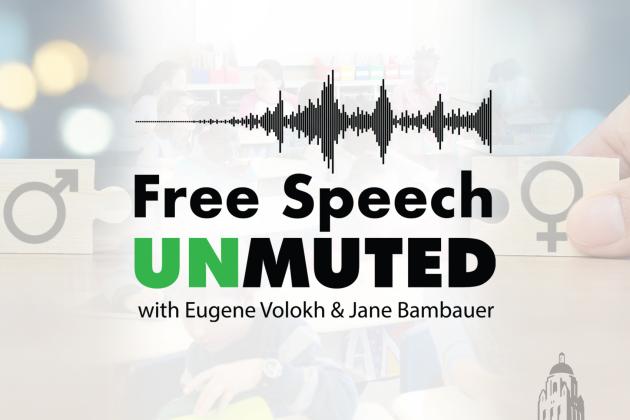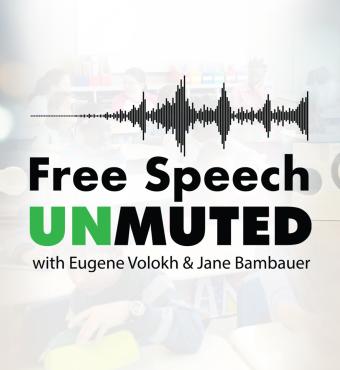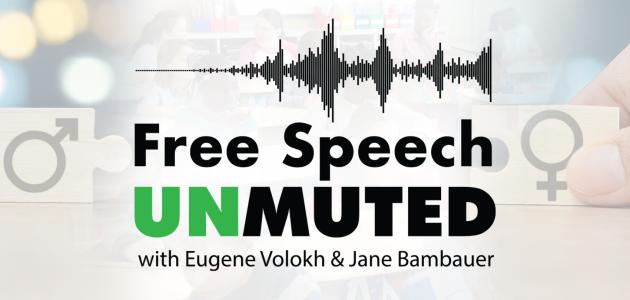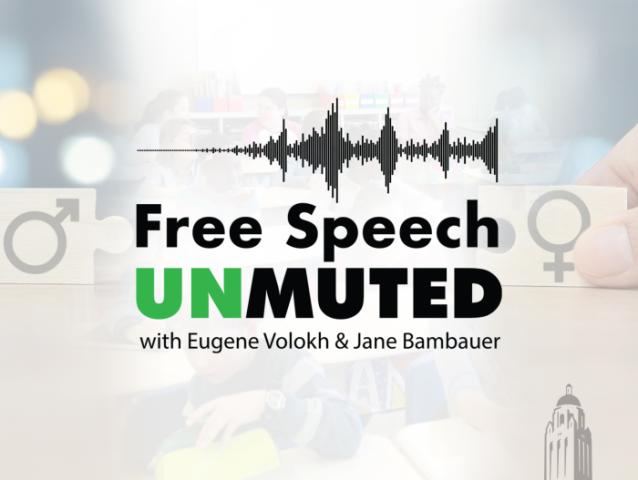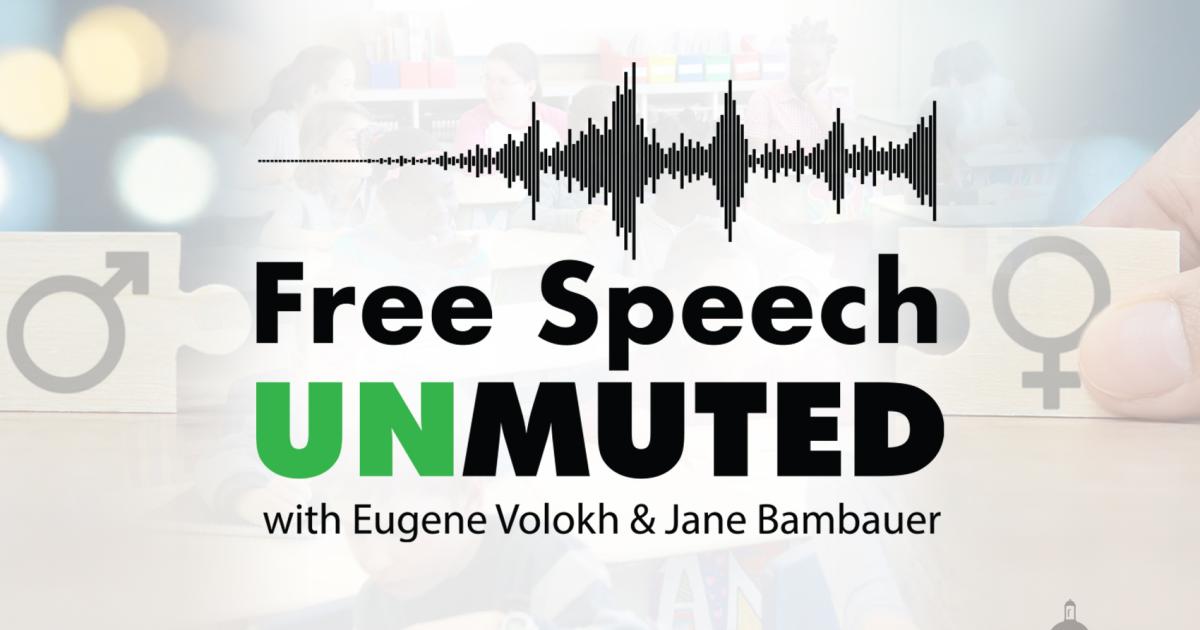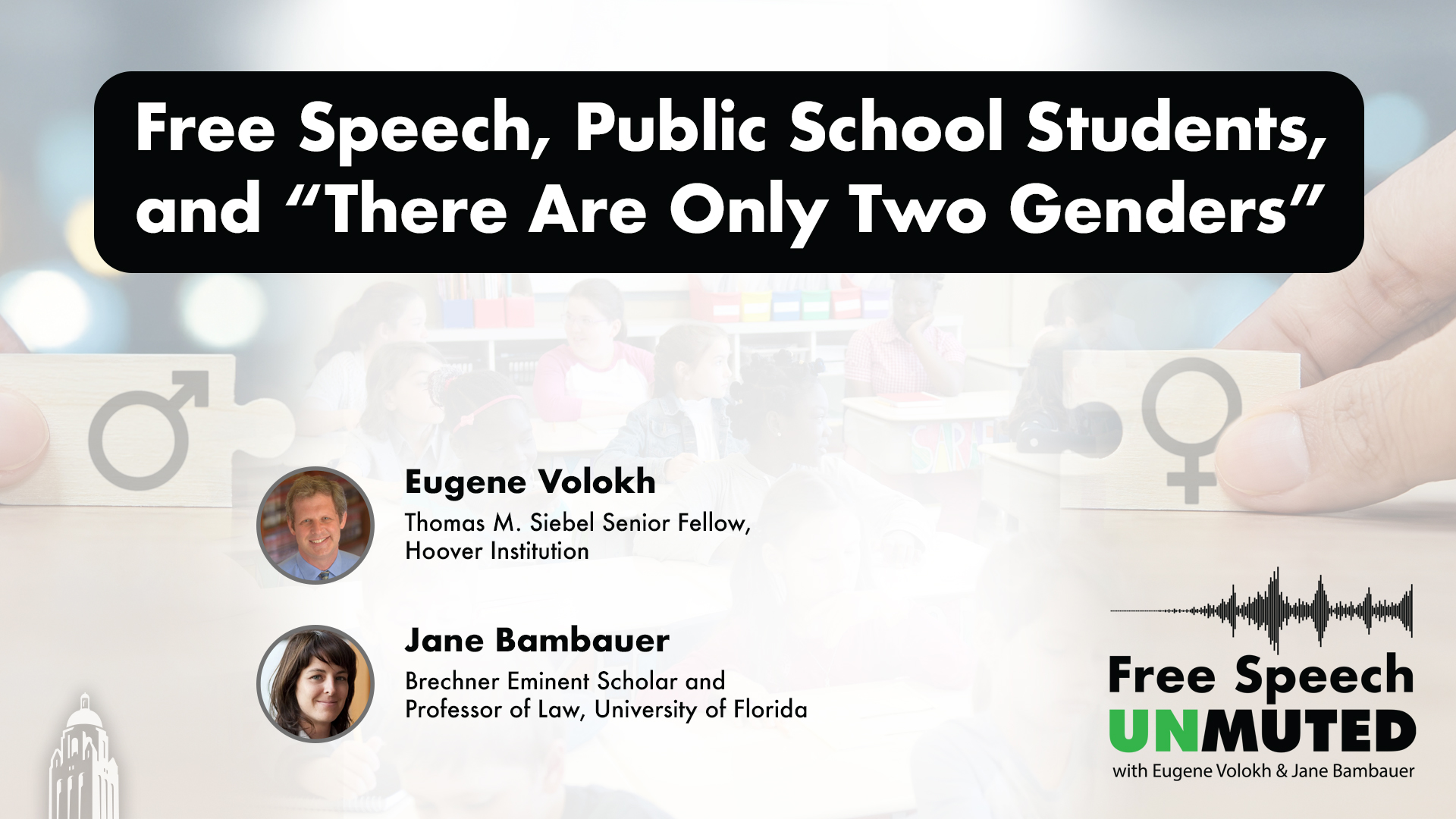- Law & Policy
- Revitalizing American Institutions
Eugene Volokh and Jane Bambauer discuss the First Amendment rules pertaining to public school students. The occasion: The Supreme Court just declined to consider a federal appeals court case that led a public school to punish a student for wearing a T-shirt saying “There Are Only Two Genders.” Did the lower court get that right?
Recorded on June 3, 2025.
WATCH THE EPISODE
>> Eugene Volokh: Welcome to Free Speech Unmuted. My co-host is Jane Bambauer of the University of Florida. I'm Eugene Volokh, a Senior Fellow here at the Hoover Institution. Today we're going to be talking about student speech, particularly not college student speech, but speech of students at public K through 12 schools.
There's an interesting recent case. Jane, tell us about it.
>> Jane Bambauer: All right, so what happened in this case called LM versus Middleborough or city of, I don't know, town of Middleborough. A student went to school wearing a shirt that said there are only two genders. And then later he, he, he was, well, he was, he was asked by the administration to take change out of the shirt during his first period of school.
And then later his, his father talked to the administration, didn't think that the administration was in the right for, for requiring him to change his shirt. And he came to school again with the same shirt, but, but this time it said there are. And then he had taped over the words only to, so that it said censored.
So there are censored genders. By the time he was wearing the second shirt at that point, it was sort of a media fiasco. So I actually think for our purposes we'll probably focus most of our time on the first time he wore the shirt. And so this tees up a question about what rights students in public K12 schools have when they are engaged in passive, at least what the courts call passive speech, meaning that it's not some sort of fleeting comment he made with his own voice, it's, it's that he's wearing a message and it has political overtones.
But the, the school district thought that they were in the clear for requiring him to change out of his shirt because they were enforcing their hate speech related clothing rule. And so that rule said that clothing must not state, imply or depict hate speech or imagery that targets groups based on race, ethnicity, gender, sexual orientation, gender identity, ding ding, religious affiliation or any other classification.
And so the school thought that his message, which by the way they, they sort of understood to mean it's a little ambiguous, but the school understood the message to mean there are only two sexes and each gender is, corresponds only with those two sexes. And, and so they thought that by wearing the shirt he was basically denying the identities of some of his fellow students who went by who, who were either trans or non binary.
And so that's the background. The First Circuit decided that the school did have the authority, notwithstanding existing speech rights of students, to, to force the student to change his shirt. And the student's family appealed or rather filed certs at the Supreme Court. The Supreme Court decided not to take the case, but Justices Alit Thomas wrote a dissenting opinion on that denial of cert.
And that in itself is somewhat interesting because Justice Thomas, at least is. Is sort of well known for having for criticizing the concept of. Of student speech rights at all. So, Eugene, I think it'd be helpful for us to know a little bit about the background precedents that were already in place by the time that the school district had to figure out what to do with this shirt.
So why don't you tell us what rights students do have?
>> Eugene Volokh: Sure. So the main rule when it comes to student speech in K12 schools comes from a case called Tinker v. Des Moines Independent school district from 1969. And there the court concluded that students. And here when I say students, I'm going to mean K through 12 students, maybe just junior high school, high school.
Not clear how it extends to elementary school. So I think it probably does extend to elementary schools. Rules for college students are different, but that students, the Cord and Tinker held, have pretty substantial rights to speak in school so long as their speech is not sufficiently likely to be disruptive.
So that means substantial rights, but lesser rights than we have in public on the street, where we can say things that are disruptive. And so long as we. We don't, let's say, physically block building entrances and whatever else, we can't be punished because they're disruptive in the sense of likely to lead to a fight or substantial distraction or what have you.
But in school, speech can be restricted if it is actually or potentially disruptive, or at least if there is sufficient evidence of that. So that's the Tinker case. Substantial protection for K12 students against discipline, but. But more limited than. Than in public.
>> Jane Bambauer: And maybe it's worth talking about what the expression was.
>> Eugene Volokh: Right. Right. That's a good point. So in Tinker, students were wearing black armbands to protest the Vietnam War. And there was some evidence that class. Some classmates were offended that there was some distraction. There was a kind of potential prospect maybe of fights or some such people.
Of course, in the late 1960s, Vietnam War was a hotly controversial topic. Classmates were likely to have relatives and friends who were fighting and possibly dying in Vietnam might have taken. Taken this amiss, might have seen that as offensive. And the dissent pointed out that there was some degree of disruption.
But the court said not enough to justify restricting this speech now since then the court has limited the rights provided by Tinker in a couple of ways. In a later case called Bethel School District vs. Fraser the court held that vulgar speech can be restricted sexually themed speech and the like.
Can be restricted in school even when it's not particularly disruptive I'm not going to go into all the details of that although I'm sure there'll be occasions in future episodes to talk about it but it's really limited to vulgarities and to sexually themed speech. And there's also case called Amors v Frederick known sometimes as the bong hits for Jesus case because that is the banner that student displayed at a school sponsored activity which says that speech that basically without any political content advocates for drug use presumably be the same for say.
Alcohol use which is illegal for minors can also be restricted even without a showing of disruption so Tinker provides the general fairly broad but limited protection and then there are a couple of these limitations. There was also then a later case called Mahanoy School District versus BL Just a few years ago, just four years ago, where the question is what happens with off campus speech.
Court didn't fully resolve that question, although it pretty strongly suggested that off campus speech by students, even when it might cause some disruption on campus, is going to be more protected than on campus speech. But how much more protected we don't really know for sure. So those are the main cases.
One other case that just for the sake of completeness that might be worth mentioning is Hazelwood School District versus Kuhlmeier, which upheld a broad authority by the school over the content of student newspapers, the official student newspaper of the school. But that has more to do with the government speech doctrine, the theory that the student newspaper is essentially a voice of the school, even though written by students, than it does with the rights of, of students to speak on their own.
So in any event, that's, that's the big picture. And one of the things that the Tinker case does is it allows what is in other contexts called a heckler's veto. So this issue had come up before where police officer sees someone speaking in front of an angry crowd, angering them and the police officer says, well, there's about to be a fight or a riot or something like that, we're going to make you, the speaker stop because of the danger of disturbance, breach of the peace, fights maybe worse, that is, that stems from public upset at your speech.
As a general matter, the court said that kind of so called heckler's veto is not permissible except in extreme cases. The job of the police is to protect the speaker rather than allow those who are threatening the speaker expressly or implicitly to basically shut the speaker down. But when it comes to speech in K12 schools, at least as lower courts have interpreted Tinker, and I think probably as Tinker is properly interpreted, whether you agree with its holding or not, the heckler's veto is alive and well.
If speech does seem sufficiently likely to disrupt school activities, at least in school, speech is sufficiently likely to be disruptive, even when the disruption is simply people get offended, people get upset. And thus as a result try to attack the person, the speaker, or even just, just start shouting and interferes, interferes with class, let's say then in that situation you can suppress the speaker speech and you can try to deter the speaker from saying these things because of a fear that offended students will violate the rules by disrupting them.
So by the way, something similar sometimes happens in Government employment that government employees under the so called Pickering test, which also has kind of a disruption element to it, can also be fired for saying things that sufficiently offend co workers or members of the public. Exactly where that line is drawn is hard to tell.
Like Tinker, Pickering in the government employment context provides considerable protection, but limited protection. But the things that they have in common also is that they do allow a certain degree of this kind of heckler's veto.
>> Jane Bambauer: And an interesting question, and I think there's, there is some logic to it though, right?
Because, because these are contexts where the government has a job to do. It's, it's trying to accomplish something, something, sort of some sort of positive mission. And of course, nothing requires a school or a government employer to, to suppress the speaker rather than using it as a teachable moment and training the rest of the people, the rest of the students, for example, to be less disruptive and to be able to handle difficult messages and whatnot.
But it just allows them to because there needs to be a certain amount of, I guess, expedience, I guess, if they really need to get something accomplished. Do you agree with that?
>> Eugene Volokh: So that's certainly a very plausible argument. I think it's an important argument. The government's position is, look, we've got a job to do here and our job is to educate kids and we can't do that.
If, if there's disruption and it may be the fault of the offended students, but it's a reality, it's happened before, it's likely to happen again. We need to make sure they learn algebra. Likewise in the, in the government as employer context, they say, look, we have to provide services, provide police protection for fire protection and such.
And if, if there's serious disruption to morale, if, if co workers are offended by each other, don't really want to work with each other, if members of the public begin to doubt whether they're going to be treated fairly by government employees, that's going to interfere with our job.
Now, of course, the policeman on the street corner also says he's got a job to do. My job is to make sure there aren't fights. And fights can turn into even worse. And the way to stop this, shut up the speaker. But we tell them, no, no, no.
And we know it makes your job harder, but you have to protect the speaker. But maybe the rule should be different in these kinds of managerial environments. So perfectly plausible position. And that is in fact why the court has tried to reach these compromises the one thing though that this means is that, excuse me, that the First Amendment in that kind of context ends up protecting basically speech that's not terribly controversial.
And once speech gets controversial enough, and probably controversial plus disapproved of by school officials may tolerate some controversial speech but not tolerate other controversial speech once it gets controversial enough, well then in that case we, then the government can shut it down. the thought is the real value of the First Amendment is precisely to protect controversial speech.
The question is what, what benefit do we get out of these speech protections if it only applies to non controversial? The answer may be some because if the speech is maybe just offensive to the school, it's then the school can't suppress it just because of that. It also has to show some degree of likely controversy and sufficient degree of that.
So maybe it's better to provide some protection even if the most controversial speech is excluded. But we have to acknowledge that that is what's happening and again that it's likely to be enforced in a, in a particular way, which is when school really likes certain speech that's controversial, then they're going to go to bat for it.
But when it doesn't, then in that case they're going to suppress it. The other thing to keep in mind, of course is as with so many of these examples, the speech may be controversial to some, but is a very important part of public debate that, sometimes you say, well, why should we protect the speech of kind of Nazis?
Or well, it's almost never about Nazis, right? Occasionally it's about Nazis, but generally speaking, whenever there's an exception for Nazi speech or hate speech or whatever else pretty quickly turns into something that is broad enough, or at least people try to turn into something that's broad enough to cover even pretty mainstream or at least views that it.
That have maybe a majority support or at least substantial minority support. They may still be bad views, but those are the very kinds of views that probably should be discussed by the public. So this is a classic example, right. Lots of people think that there are only two genders and that when, that when individuals say I'm neither male nor female or something like that, then except with very rare situations of outright, outright physical disorders, or let's say physical conditions where, where somebody might be born with both.
Kind with both male and female genitalia or something like that, or chromosomal, chromosomal anomalies, let's, let's say physical anomalies. Setting those aside, people say, well, when those are just psychological conditions, there may be mental illness and we shouldn't accept that as reality. Now, others disagree, but it's a very big part of debate.
Likewise, there's a very big debate about what the government should do. So one message from their only two genders is, look, whatever you might think, we as a society, including our legal system, shouldn't try to accommodate people's views that there are more than 2 genders. That too is a very important point.
Political dispute. Now, of course, it plays out differently in different contexts. My understanding is the view that there are men and women defined by biology. And that's the way we should operate is actually probably gets majority support when it comes to things like transgender athletes competing on women's sports teams, at least looking at surveys, that's actually a popular view, even if it's unpopular among some people, including some school administrators.
>> Jane Bambauer: Yeah, but it also might be context specific to sports where there is a sort of zero sum issue in the female category.
>> Eugene Volokh: Exactly, when it comes to certain kinds of sexual privacy, for example, who should be allowed in spaces where women, for example, are nude. There's actually a very recent decision from the ninth Circuit on that question.
But outside of schools, I think there also is probably pretty broad support for some, some variants of their only two genders or at least some implications of that phrase. It's a slogan and as such is not super precisely used. On the other hand, when it comes to, for example, whether the law should ban discrimination based on gender identity, there, there's probably majority support for indeed banning such discrimination or substantial minority for the contrary view.
So in any event, so what essentially the school in this case was saying is it's okay for us to suppress this pretty important viewpoint while ourselves supporting and arguing for the opposite viewpoint. If you want to express the opposite viewpoint, that there Are lots of genders, then by all means, please do that.
We'll even perhaps praise you for it. But if you don't, we will discipline you. And ultimately the discipline, if you keep violating the rules, may be suspension or expulsion. So that's one question is, should we say, look, this is so important that people be free to express these views even in K through 12 schools, that we have to tolerate some degree of disruption as a result, or should we say, look, express yourself elsewhere?
Of course, that raises the issue whether the school, can actually have 247 control over student speech and let's assume the standards they outside of school, if that they have disruptive effects in school. But that's at least the case in an issue not raised in this particular case, it's actually raised in a case that I'm litigating.
We're still waiting for appellate court opinion on that, but not in this case.
>> Jane Bambauer: So, Question. Yeah.
>> Eugene Volokh: Yes.
>> Jane Bambauer: Well, so, yeah, that reasons nicely. It seems that what the school did and what the First Circuit adopted was that it. It used the logic of the Bostock decision where the Supreme Court basically embraced transgender identity as one of the list of protected statuses, to then justify this, as you put it, this, sort of asymmetric.
This asymmetric sort of enforcement of speech on campus. So that saying something like there are only two genders is treated as equivalent as saying something just overtly racist or like, like, like some race is inferior or something like, imagine wearing a shirt saying that. Right. And so the First Circuit, they avoided asking whether.
They avoided the question of whether the shirt actually literally interfered with the rights of other students and instead focused on the question from Tinker of whether there was a substantial disruption or material disruption, I should say. But in finding that there was material disruption, they thought that this was demeaning of a category that especially protected, basically.
And it follows it, or at least it is in line with some other circuits that had found that there's, that the line here, clearly the shirt is pretty close to a line, the line wherever, based on where the circuits have drawn the lines before. So just to give a couple examples, the ninth Circuit had.
Had found that a shirt that said homosexuality is shameful was materially disruptive for the same reasons, more or less, that the First Circuit went with in the transgender, to protect transgender identity here. But at the 10th Circuit, someone wore a shirt that said, be happy, don't be, be happy, not gay.
That was not demeaning. It was only, and I'm quoting here, tepidly negative. And so, and so somehow that was found to not be likely to have the same level of dis. And so I guess I have a couple questions. First of all, is that about, are the, do you find this convincing that they're drawing lines and about the right place given the overall goals of providing students from some free speech?
Especially because, as you said, the whole premise of Tinker is that students as they age need to learn how to debate with each other and find their own voice politically and whatnot. And I guess the, the second question I have is, is there an. Once we have law, especially protecting certain people based on identity, does that mean that there really is something different about political speech that's about identity?
Like identity politics might actually get this special carve out even within political speech in a way that military families, for example, because it's not a protected identity, even though it could be core to somebody's to some students, sense of self and pride because it's not a legally protected identity.
Their sort of sense of offense from an armband during the Vietnam era would not, would, would not raise the same sort of, I don't know, legalistic treatment.
>> Eugene Volokh: Right. So I think you've hit the nail on the head here. Excuse me. So far, what I was talking about is the big picture rules from the Supreme Court with especially.
Especially coming from Tinker, which really is just focused on the question of disruption. And the disruption can come from whatever viewpoint is sufficiently offensive to enough people. But in this case, the First Circuit tried to particularize that some and it focused less on people simply being offended. But the argument is that they're negatively psychologically impacted.
And the First Circuit articulated a, articulated a test and said school officials may bar passive and silently expressed messages. And surely that means they can also bar oral statements as well as T shirts, but maybe uneven T shirts by students, even when that targets no specific student. So it's not like individualized bullying if the expression is reasonably interpreted to demean one of those characteristics of personal identity, given the common understanding that such characteristics are unalterable or otherwise deeply rooted and, and that demeaning them strikes a person at the core of his being.
And two, the demeaning message is reasonably forecasted to poison the educational atmosphere due to its serious negative psychological impact on students with a demean characteristic and thereby lead to symptoms of a sick school. Symptoms therefore of substantial disruption. So on the one hand, the court is trying to be more specific and narrower than just anything that's disruptive.
And it targets speech that it sees as likely to have actually negative psychological impact and focuses on particular kinds of speech, speech that is demeaning of characteristics of personal identity. At the same time, in being this narrow, the court embraces, that is to say the First Circuit. The Supreme Court did not agree with the First Circuit.
It just declined to review the issue. And the Supreme Court has repeatedly said that's not Supreme Court precedent that just lets the lower court decision stand. The issue may come back up to the Court at some point. But the, but the 1st Circuit essentially said they're adopting kind of a quote, hate speech, close quote, quotes mine.
But the kind of label that people have used even though the First Circuit didn't, exception when it comes to K through 12 speech. Frankly viewpoint based exception that there are certain viewpoints that we view to me as demeaning of identity that as a First Amendment matter are just not protected when it comes to K through 12 speech as a matter.
So that's just a first amendment rule that is itself a viewpoint based rule within a doctrine where the Supreme Court has generally said by and large the worst thing that the government can do is to set up viewpoint based speech restrictions. Well, here the First Circuit was essentially saying the First Amendment itself adopts this viewpoint based distinction between speech that is demeaning of characteristics of personal identity and speech that expresses other views or perhaps even contrary views praising certain characteristics of personal identity.
So again, one might say, well, maybe that's proper. Maybe, maybe we should have broader hate speech exceptions. There is no such exception under the first amendment law. The supreme court has made that clear. But some people disagree. Or, or maybe when it comes to K12 education, whether it's because of the institutional setting that the government has a mission or because there are children involved, maybe we should have this kind of exception even for political advocacy.
That's very much a part of current debate. So that's possible. But one could also say, look, this is a dangerous precedent to adopt a viewpoint based First Amendment limitation even in the K 12 school context, and especially because we see in this very case that it's being used to restrict serious discussions.
After all, this isn't just about there are only two genders, right? Let's say somebody just said, look, yeah, absolutely. I, I think that up until a few decades ago, we used to think that, that when people who have a particular biological sex believe that they are of an opposite sex are.
Or opposite gender, that, that's, that was seen as mental illness. And, maybe that's right, maybe not. But, we at least ought to be able to discuss this. That too is just as much punishable under the 1st Circuit's test. In fact, it's hard to see how one could have a serious discussion, whether in class or in the cafeteria, on a subject like this, where, one side can get you suspended or expelled and the other side, well, you're perfectly free to express.
Now, one possible answer is maybe, it's better if these discussions don't happen in schools. Or maybe this is one area where really we should propagandize students because we think there's the right answer that is psychologically helpful to classmates. But I just want to highlight what kind of a big step the first Circuit.
>> Jane Bambauer: Yeah, well, it seemed that there was a little breadcrumb that allows maybe, other, other courts dealing with different facts to avoid the full breadth of this, this ruling because they do distinguish the T shirt sort of bumper sticker slogan from what they called, let me get the passage here, expression that is fleeting or admits of nuance.
So something about fleeting, fleeting maybe matters because it's not, it, maybe it's only heard by a specific audience at a, for a small amount of time or something. But the admits of nuance that, it's a vague phrase to hang too much on. But maybe the idea there is that something as simple as an armband or a T shirt doesn't actually progress debate that much anyways.
I mean, I have to say I'm sort of sympathetic to that idea a little bit. Except that if we go down that road, then it seems that Tinker was also decided wrong.
>> Eugene Volokh: Right, right, the black armbands in Tinker were not meeting or-
>> Jane Bambauer: Not nuanced, correct.
>> Eugene Volokh: But beyond that, first it's defleating.
it's true that a conversation that is that you overhear is fleeting. It's likely to be done in a few minutes, whereas the T shirt, you'll see again again during the day. On the other hand, if one student can engage in a conversation, other students could too. And in many ways I think it's people get more upset at overhearing something that they can't close avert their ears, right?
I mean they can move, but there they are sitting at lunch and then somebody next to them is. Is saying, perfectly calm tone of voice but saying look, I think that, that we've. Society has gone down the wrong path in recognizing more than two genders. I think there are only two genders, and keeps talking about that.
At least with a t-shirt you can avert your eyes, you can't avert your ears with a conversation. And as to admitting nuance-
>> Jane Bambauer: Well, that's true. But on the fleeting point for a second, it might be though that when someone's wearing a T shirt then there's a reaction of there's not a back and forth as much as maybe a likelihood that other people will then wear T shirts that try to counter the message.
I can imagine maybe the medium being the issue where students who put into practice claiming their beliefs all over their apparel induce other students to do the same thing. Thing, whereas a back and forth conversation maybe is a, you know. So I suppose. Although if you're really worried about students kind of escalating and having more and more message bearing T shirts and that's more and more distracting.
It's funny, that particular message. Whereas the opposite message, which may be, let's say somebody wears a there are only 2 genders T shirt in response to a transgender pride T shirt. Right, right. Yes.
>> Eugene Volokh: One of those is being targeted, not the other. And again, as the admitting of nuance, I entirely agree.
I think our views as educators is we wish that our students, college students, but probably we'd wish the same thing we were teaching high school would focus less on slogans and more on real discussions. But the problem is, first of all, again, the school tolerates a lot of speech that is not particularly nuanced.
But also, how do you know as a student when what you say is likely to be seen as sufficiently unnuanced? Like say, well, you could have expressed your views, but just with more nuance. How much more nuanced? I thought it was pretty nuanced. No, no, no, you weren't nuanced enough.
You didn't take, you didn't consider plausible counterarguments. Well, I consider this one. Well, that's not nuanced enough. Right, right. That can't be a first test. I mean, the court may have been explaining that in this case it thought that it was missing nuance, but that cannot possibly be a legal limitation on this First Amendment tested analysis, by the way.
That's probably right. And go ahead. I should say that courts have generally said that students that schools can implement, implement dress codes that say basically you have to wear a solid blue shirt and tan slacks or that would be uniform, actually. But you could a dress code that says you have to wear a solid shirt and solid slack blacks or something.
>> Jane Bambauer: Like that, or no messages on the shirts.
>> Eugene Volokh: Right. And note, that is actually a much more, much broader restriction on students.
>> Jane Bambauer: Right.
>> Eugene Volokh: Right, students are still free to say things, but they lack the opportunity to express themselves through the T shirts. But it's content neutral and courts have upheld it on those grounds.
And that's a recurring question in First Amendment law. Should do we want to have broader restrictions on speech, but at least are content neutral, or do we want to allow the government to narrow them, but narrow them in ways that are content based and perhaps even viewpoint based?
>> Jane Bambauer: Well, let me even try an argument that maybe it was only barely about the T shirt anyway. This might be too clever, but I, I kept thinking about it as I was reading the case. So, so his shirt actually said there are only two genders. It did not say that.
he doesn't recognize someone who's born of one sex who, who identifies as the other gender. Right. And so if, if the shirt denies the existence or validity of anything, it would only be the non binary that they, them students, which I don't think Bostock. I went, went and looked to see if there was any reference to non binary in Bostock.
I don't think that at least the Supreme Court has recognized non binary as post transgender as a, as a protected category. And, and yet everyone on campus knew what he meant. Right. If they already know what he means, then his own face is the message. Right. They don't like this kid because they, because they had worn other sort of political shirts before.
They kind of assumed they knew the full package of his beliefs and, and they interpreted his shirt accordingly. And so, and so I, I think, I mean, this leads me to think that there really is a, to agree with you that there, there is a problem of, of viewpoint non neutrality if they're not even sticking to the literal words of the shirt.
>> Eugene Volokh: Well, slogans often do acquire meanings that are different from what they literally say.
>> Jane Bambauer: Okay, that's, that's a fair point.
>> Eugene Volokh: Right. So a common gun rights slogan is guns don't kill people. People kill people. I mean really, Guns don't kill people. No, no, what they mean is you shouldn't attribute the murderers, you shouldn't attribute culpability to the gun.
You should focus on the murderer and that the murderer would have killed in other ways or whatever else. You could agree or disagree with the slogan, but I don't think it makes sense to parse it hyper literally. And the same is true with, with, with very many liberal slogans like, well, somebody saying, let's say wear a T shirt saying pro choice.
You're in favor of choosing to eat animals. Right. You're in favor of choosing to, I don't know, to kill people. Right? That's a choice too. No, no, I'm not saying that. But pro choice means something very specific in our current debate. Maybe there are only two genders is a little bit less clearly, clearly tied to a very, very particular message.
But I think it makes sense that, that we would interpret it, that a court would say, look, school might interpret it as it's commonly understood and that in fact, and that the speaker could say, look, people understood what I meant. And don't, don't be too, too literal about the, about the reading.
>> Jane Bambauer: Yeah, that's what I figured. I was being a little too. Well, I called it clever. But you're right, I'm probably actually being too narrow or literal. So yeah, well, this is one of the things we sometimes do.
>> Eugene Volokh: Sometimes you try to avoid it.
>> Jane Bambauer: The court itself there talks about how one problem with the shirt is that it denies that it, it communicates that there are only two and denies, the non gender, non conforming.
And if we're only focusing on that section subsection of the population, then I think some of the hate speech, taking advantage of protected categories starts to go away. But anyway, okay, so what else is there to say about this case then? Maybe do you want to explain a little bit about.
Do you have any thoughts about the dissenting voices who really wanted the Supreme Court to take the case?
>> Eugene Volokh: So I do want to signal one interesting feature of this decision. There are two dissenters. One is Justice Alito, who has generally spoken out before about freedom of political speech in schools.
He has written separate opinions which, which stress that, that schools should have much more limited authority to restrict political speech there and, and even more so out of school. The other was Justice Thomas. And Justice Thomas, like Justice Hugo Black in the Tinker case, has taken the view that basically First Amendment rights don't apply at all to school discipline decisions in K through 12 schools.
So what he said was, look, under current law, our precedents say that First Amendment rights do apply unless there's sufficient evidence of disruption. And I agree with Justice Alito that given that Tinker's binding precedent that lower courts must faithfully apply, the lower court got this wrong. But he would say, look, we should just avoid all these problems by just leaving things to school authorities.
And if school authorities want to restrict supposedly unpatriotic speech or anti war speech or whatever else, that's fine. And the corrective to that is political right. That if parents don't like it, they can elect a new school board. And another corrective is people pulling their kids out of school and send them to private school, which may impose their own rules, but ones that the parents like.
And of course private schools cost money. Although to be fair, Justice Thomas has also been one of the voices on the Court who has spoken out in favor of constitutionality under the establishment clause of school choice programs. Among other things, because they provide more options for parents that, that the parents can choose whether to send their kids to religious schools or to more free speech tolerance schools or whatever else.
So but I think one thing.
>> Jane Bambauer: So he has a fully thought through an alternative model. But since we're not doing that package and we are under the tinker and other constraints that we are, then we ought to at least apply the rule.
>> Eugene Volokh: So one thing that this reminds me of is something that I observed in many past cases as well, which is just the similarities between Justice Thomas and Justice Hugo Black.
So Black was a very liberal justice, Thomas is very conservative. But they both understand themselves as originalists. Black framed himself as a liberal originalist. They're both, I think, somewhat more open to categorical rules rather than balancing tests or tests that focus on things like disruption. And in this particular context, Justice Black was the leading, even though he was quite liberal and K through 12 school rights were generally associated with liberals at the time.
He dissented in Tinker and said look, we should not put ourselves in a position that of, of second guessing school decisions. Let's just have a categorical rule. The schools can impose whatever restrictions they want. Justice Thomas is now saying something similar. His arguments are even more historical than Black's.
He points to long standing history of these kinds of restrictions, or at least what he understands to be long standing history, these kinds of restrictions, but pretty similar in many ways. There are other such examples. Interestingly, Justice Breyer, in many ways similar to Justice Felix Frankfurter who also served at the same time as, as Hugo Black did.
Very, very much different from Thomas and Black, very much more into balancing into kind of case by case adjudication and the like. The last thing that I wanted to mention though is something that, that I heard from a law professor. I wish I remembered exactly who it was.
I think I remember but, but I don't want to get it wrong. So let's just say credit to someone else who's a very liberal professor. And again, liberals have generally been associated with the notion of free speech even in government controlled domains. But he said, look we have this rule that parks are open to public speech.
Okay, but a lot of people don't like going to a park and seeing a demonstration there and hearing messages, whether they're offensive or loud or whatever else. And rich people have nice big backyards. Rich people belong to country clubs. Rich people can go to other places where they've got lots of seclusion and can play with their kids and have fun and they can kick out anybody who wants to demonstrate there.
What if the city says, we want to give up our poor citizens and middle class citizens the same kind of thing? Well, no, no, no, no. You've got to protect free speech. Okay, but aren't you then denying, through this speech protection, denying to ordinary citizens the things that rich people have.
You could say very much the same thing about schools, too. I think a lot of parents who send their kids to private schools do it in part because they want the kids to go to an environment that inculcates certain values that they like, even by restricting expression of other values.
Now, to be sure, some parents may want to send their kids to schools precisely because they're broadly open, but many parents, whether they're religious parents who want to send their kids to a religious school, or liberal parents, want to send their kids to a liberal school that teaches liberal values, or conservatives want to teach conservative values.
If they have the money, they can do that. But Tinker essentially says, well, whatever those benefits are of private schools that many people perceive for their kids, well, this is one kind of benefit you can't have in public schools because it's so important to protect the speech rights of the students.
Again, only in public schools, because the First Amendment doesn't apply to private schools. So, I'm not sure how persuasive this argument should be because there are good reasons to protect speech in public parks and public schools and.
>> Jane Bambauer: Right, and especially because Tinker, it does have that material disruption right option.
>> Eugene Volokh: Right, so in fact, or maybe the variant might be we need to have a material disruption option. Every private school would certainly restrict speech that is disruptive. And if it didn't, the parents would demand it because they say, we want. We are sending our kids to school to learn various subjects and not just to say whatever.
Whatever they want to say. Well, shouldn't schools have the same authority?
>> Jane Bambauer: Yeah, which, which, okay, at least the First Circuit suggests that they do. But, but if they enforce the no material disruption along one ideological, direction and not another, does that. Does that undermine the entire rule, you know.
Yeah, I'm glad I'm not a public school administrator because I get the problem. I think this, if the administrator was here, they'd say, well, some messages do have differential impact on the students and based on viewpoint. Right, that a general viewpoint saying everyone is accepted. If you don't believe that, you still haven't necessarily personally been harmed by the idea of open accepting.
open acceptance, or at least it's hard to make that case. It's much harder to make that case than to make the opposite case, that some, somebody who's denying the acceptance of. Of some belief or identity is excluding and, and, indirectly at least targeting a subset of individuals, so.
>> Eugene Volokh: Right, so in any case, I think all the arguments, I think it sounds like it's a very difficult area. I sympathize with school administrators. I sympathize with judges who are trying to parse the precedents, but also think through the practical realities that administrators face. And of course, with things like the Israeli Palestinian conflict.
This just highlights the difficulty of some of these things. On one hand, the First Circuit's test would allow the suppression of a good deal of anti Israel speech on the theory that set aside whether it's anti Semitic, there may be students in the school who are Israeli or Israeli.
Yeah, either Israeli American, but may just be Israeli. Maybe Israeli citizens. And somebody saying, yes, I think that, the Palestinians are quite right to try to destroy Israel. And if, and I think Israelis are guilty of war crimes and every Israeli is complicit in that. Not my views, but I think views that are important part of debate.
Well, that could be restrictable. Likewise, speech that says, well, Palestinians are dying in Gaza, but, that's what happens when your government attacks someone else and then uses you as a human shield. Look, 3,000 Americans were killed in Pearl Harbor. How many Japanese did we, including Japanese civilians, did we kill in response?
>> Jane Bambauer: Eugene, but if the high school students say that level of detail on each side, I would be happy. I would be.
>> Eugene Volokh: In a sense, you might at least say right, right, right. That is, that is something more than just slogans. But you might be happy, but lots of people won't be happy, right?
Classmates won't be happy. Teachers might not be happy. Parents may not be happy. School administrators may not be happy. So one possible argument is, look, that shows the problem with the First Circuit's position because it suppresses all of this advocacy on all sorts of topics, on the, all sorts of a particular set of topics, but lots of different versions of those topics.
On the other hand, you might say, well, yeah, the First Circuit was right. You gotta be able to suppress speech like that because otherwise students won't be learning algebra. Back to algebra.
>> Jane Bambauer: Back to algebra.
>> Eugene Volokh: Always back to algebra. Very difficult question, but I hope at least we've, we've, we've explained some of the, of the legal, legal nuances that, that come up there and we try.
>> Jane Bambauer: And we didn't mention President Trump once.
>> Eugene Volokh: What do you mean? You just did.
>> Jane Bambauer: Still, it's, it's hard to go a show without President Trump in the mix. So. Yeah. All right. Well, great to see you.
>> Eugene Volokh: Great seeing you, as always. And we'll have another one of these in a couple of weeks.
>> Speaker 3: This podcast is a production of the Hoover Institution, where we advance ideas that define a free society and improve the human condition. For more information about our work, or to listen to more of our podcasts or watch our videos, please visit hoover.org.








